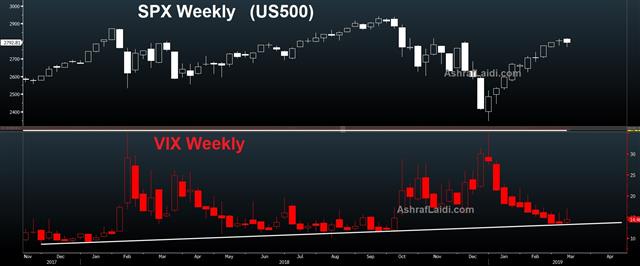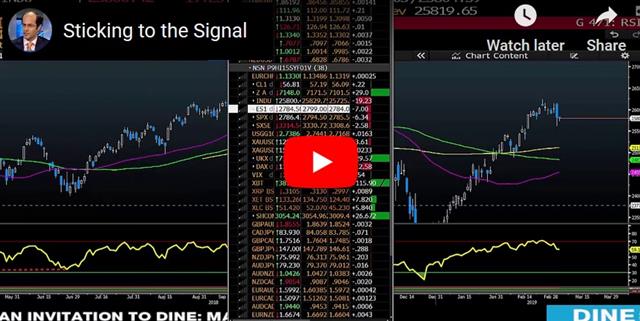Intraday Market Thoughts Archives
Displaying results for week of Mar 03, 2019From ECB to NFP
The euro licks its wounds ahead of the US Non-Farm Payrolls after Thursday's sharp downward revisions from the ECB. The central bank pushed out guidance and announced a new round of targeted loans in a series of moves that put the euro into a tailspin. The yen is the winner of the day after intensifying risk-off phase in indices. Canadian and US employment data is coming up next. The EURUSD premum short was stopped out by 3 pips (1.1177 low vs 1.1180 stop), while the short DOW30 was closed for 400-pt gain. A new Premium trade has been issued moments ago.

We warned yesterday that an extension in the ECB's forward guidance was overdue but they had hinted at a reticence to make a change so few economists were forecast a change. Draghi decided to be more aggressive as the latest ECB forecasts cut the growth estimate this year to 1.1% from 1.7%.
In response, the ECB pushed out guidance on rate hikes through the end of the year and announced TLTROs. What was especially concerning was a warning from Draghi that risks remain tilted to the downside on growth and inflation. There were also reports afterwards that some governing council members believe growth is even softer.
A fall in the euro wasn't surprising but the way it cut through the 2019 and 2018 lows – both major support levels – is telling. The euro closed at the lowest since June 2017.
In the bigger picture, the US dollar and yen were broadly stronger as risk aversion hit again. The S&P 500 fell back below the 200-day moving average. In FX, the dollar and yen are beginning to clear key medium-term levels. Notice that SPX is testing its 200-DMA, while the DOW 30 remains 200 pts away above its 200-DMA, a situation, which could suggest that DOW30 may extend to 25130 before stabilizing.
With the recent pickup in risk aversion Friday's non-farm payrolls report bears closer watching. The consensus is for a 180K reading after the 304K jump in January. The risks are that a downside miss intensify the latest round of worries and hurt USD/JPY.
ECB & TLTRO Explainer
The ECB decision is up next and all eyes are on the downward revisions to growth and inflation as well as any info on the TLTRO (more below).The Bank of Canada continued its retreat from higher rates in a surprise change to its forward guidance that undercut the loonie. NZD is the day's strongest performer, closely followed by AUD, while GBP is the only losing currency vs USD.
إستغلال الفرص داخل النطاقات (فيديو للمشتركين)
We warned the BOC might drop the explicit guidance toward higher rates in its statement and that's exactly what happened as Poloz replaced it with a watered down version that highlights a mixed picture and saying that it will take time to sort out.
USD/CAD jumped to 1.3450 from 1.3380 on the headlines. The pair was also boosted by a dismal Canadian trade balance report that highlights the lack of progress on boosting non-energy exports. In the day ahead, the BOC's Patterson will further clarify the outlook but the likely outcome is a further warning on economic weakness perhaps mixed with some longer-term optimism.
The US trade picture also darkened further as the December trade deficit missed expectations. The numbers are undoubtedly skewed by tariffs but it increasingly looks like companies boosted trade in the lead-up to the tariffs. That artificially raised activity and the months ahead could continue to see a drawdown in inventories.
The ECB announcement is due momentarily (12:45 GMT), followed by Draghi's press conference 45 mins later. Yesterday's leak suggested sharp reductions in forecasts for GDP and inflation this year with inflation projections trimmed through 2021. The new numbers will set the table for another round of TLTROs but those may not be announced today. Draghi, however, could soon be facing questions about what tools the ECB is prepared to deploy. A removal of the hiking bias is also overdue.
Difference between Refinancing Operations and Quantitative Easing Program
The ECB's refinancing operations, known as Targeted Long-Term Refinancing Operations are aimed at encouraging commercial banks in the Eurozone to borrow money from the ECB at very favourable rates. Unlike the quantitative easing program (which ended last year), these operations are made available to banks as an incentive, whereas the quantitative easing program comprised of the ECB purchasing bonds from banks and companies. QE may have had a rapid downward effect on yields and rates but did not necessarily lead to increased lending, which may be more negative for EUR than LTROS and TLTROs. In other words, the refinancing operations require borrowers (banks) to approach the ECB to take advantage of very low rates, which means the operations are more directly targeted at improving lending to the real economy. Banks with decent net lending figures will be able to borrow funds from the ECB at rates as low as -0.40%, enabling them to use the proceeds to lend out at higher rates.اليورو: من التيسير الكمي الى التمويل
ظهرت تقارير في وقت سابق اليوم ، أن البنك المركزي الأوروبي سوف يقلل من توقعاته الاقتصادية بهامش كافٍ من أجل تبرير موجة جديدة من القروض لإعادة تمويل البنوك. كيف سيؤثر هذا على اليوروفي إجتماع المركزي يوم غد الخميس؟ التحليل الكامل
Onto the Bank of Canada
Will the Bank of Canada decision finally move these quiet markets? The announcement (no press conference) is due in about 30 mins from now (10:00 EDT, 15:00 GMT/London, 19:00 Dubai). Will they reverse their hawkish stance? See further below. EUR briefly fell on reports that the ECB will cut its economic forecasts to justify a fresh bout of loans to banks according to unnamed sources. More details emerge in Thursday's ECB announcement. Below is the Premium video outlining the latest index trade.
Will the BoC Reverse?
The loonie is growing more vulnerable to USD strength. The Bank of Canada gathers shortly at a non-press-conference meeting. A change in interest rates is extremely unlikely, but the BOC will surely acknowledge that its base case of rising investment and solid growth is off-track. The key for the market will be whether the BOC abandons its current hiking bias at the end of the statement. The current phrase is that "the policy interest rate will need to rise over time into a neutral range to achieve the inflation target."Most economists think they will wait until new forecasts at the April meeting to remove it but in the past they haven't been against moving earlier once they see which way the wind is blowing. Still, it would be a surprise and put USD/CAD on a path to 1.35.
ISM Boost to US Outlook
Signs emerged yesterday that the US economy is holding up as the ISM non-manufacturing index jumped to 59.7 from 56.7. The market periodically flirts with worries about a US slowdown and that's been evident over the past week but with the survey climbing back near cycle highs and the US-China trade spat likely headed towards a deal, the outlook has brightened. Looking ahead, a jump in new orders to the highest since 2005 points to solid growth after a poor Q1.EUR/USD hit a one-week low of 1.1286. A rebound in US growth combined with the continued malaise in Europe threatens a fresh decline. EUR/USD has been relatively quiet in a 1.12-1.15 range in the past four months but the 2018 low of 1.1213 remains within striking distance and a break could spark a quick fall.
Gold Seasonals & Doubtful Risk Appetite
More signs of a US-China deal boosted risk appetite initially on Monday but yesterday's pullback in indices (biggest in 4 weeks) underscores our belief that a deal is priced in. Gold is down 2% so far this month (it's only the 3rd trading day of the month), and it's the worst monthly performance since July (more on gold's notable notable monthly seasonals below). Data watchers keep an eye on the US Feb services ISM at 10 am NY (3 pm GMT/London) expected at 57.4 from January's 56.7, which was the lowest in 6 months. Also watch speeches from 3 Fed officials today. A new Index trade for Premium subscribers has been issued, supported by 3 charts.

Reports of progress on a US-China trade deal and a Trump-Xi meeting at the end of the month initially boosted Chinese stocks and risk assets but the effect faded in North American trade and US stocks finished lower after initially climbing. Part of the reason is Huawei's announcement to file a lawsuit against the US govt over a law that bans US govt agencies from buying Huawei products.
Looking ahead, there are few positive catalysts in the pipeline if a trade deal is fully priced in. Moreover, closing a deal may lead to a pivot towards the dispute in Europe and an escalation on that front. For now, the Fed is a neutral factor and Chinese stimulus is also already priced in. Also watch speeches from 3 Fed officials today (Rosengeren, Kashkari and Barkin).
Seasonally, March is a usually solid month for risk trades (but April has been the most positive over the last 15 years for US indices) but that's a minor factor compared to some of the gathering headwinds. On Monday, the S&P 500 peaked at the late-September highs then quickly reversed. Don't forget that March has been the worst month for gold over the last 15 years. We're only 3 trading days into the month and it's alrady the worst monthly performance since summer.
Looking ahead, the market is raising fresh questions about the US economy with Q1 growth looking like it could be below 1% and Q4 likely to be downgraded. One of the finest forward-looking indicators is the ISM non-manufacturing survey and it's due up Tuesday at 1500 GMT. The consensus is for an improvement to 57.4 from 56.7. It remains well-within expansionary territory but a soft number could spark jitters in a market that may be overextended. Also watch the sub-indices such as employment, new orders and priced paid. Earlier today, UK services ISM improved to 51.3 from 50.1










